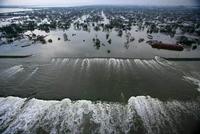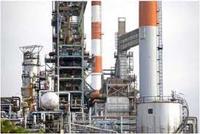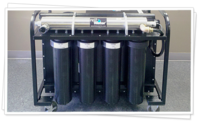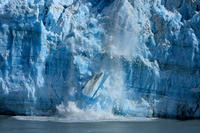-
Changes to levee system would reduce storm surge risks to New Orleans: study

Historically, the design of Southeast Louisiana’s hurricane flood risk reduction system has hinged on raising and adding levees in response to river or hurricane events that impact the region. A new study shows that the lowering of man-made levees along 55-kilometer section of the west bank of the Lower Plaquemines river to their natural state, to allow storm surge to partially pass across the Mississippi River, will decrease storm surge upriver toward New Orleans.
-
-
Harnessing energy from wind whipping through urban concrete canyons
Two Drexel University students developed a wind-harvesting concept which would exploit the wind whipping through “concrete canyons” between buildings and skyscrapers in large urban centers. Their concept involves a system of wind turbines that could be installed in streets and spaces between buildings, using flexible sails to divert otherwise turbulent winds into a more useful stream.
-
-
Lawmakers, citing shortcomings, threaten funding for chemical plant safety program

Heads of three congressional panels urge DHS secretary Janet Napolitano to take to correct shortcomings in the Chemical Facilities Anti-Terrorism Standards (CFATS) program. “As the authorizers and appropriators of this program, we write to you to express serious reservations about continuing to extend CFATS funding without evidence of substantial programmatic improvement,” the three chairmen write in their letter to Napolitano. The lawmakers pointed to flaws in the program’s risk evaluation system, compliance hurdles, implementation delays, and the failure of the program to identify vulnerable facilities.
-
-
Motivating businesses to adopt building resiliency standards
Increased resilience for buildings in the face of hurricanes, earthquakes, terrorism, or cyberattacks has been a major national security focus over the past decade. Such resilient buildings not only would be less susceptible to damage and work interruption but could become community gathering places in a general crisis. It will not be easy, however, to secure voluntary adoption of resiliency standards by industry and builders without adequate justification.
-
-
Harvesting carbon dioxide to produce electricity
Electric power-generating stations worldwide release about twelve billion tons of CO2 annually from combustion of coal, oil, and natural gas. Home and commercial heating produces another eleven billion tons. Researchers developed a technology which would make the CO2 react with water or other liquids and, with further processing, produce a flow of electrons that make up electric current.
-
-
Cost to U.S. of cybercrime lower than earlier estimates
The Center for Strategic and International Studies (CSIS) and security firm McAfee published a revision of McAfee’s previous estimate of the cost of cybercrime to the United States, reducing the amount from $1 trillion to $100 billion. Experts say this should not be a reason for complacency.
-
-
State Department approves U.S.-Canada pipeline, but it is not Keystone
The State Department has approved a U.S.-Canada pipeline, but it is not the Keystone XL project which is still being debated. The Vantage Pipeline will carry ethane from North Dakota through Saskatchewan into Empress, Alberta.
-
-
UMaine student develops affordable option for shoring up Maine’s aging bridges

The State of Maine Department of Transportation is responsible for 2,772, or 70 percent, of the bridges in the state. A 2007 report found that of those bridges, 205 are more than 80 years old, 244 were considered in poor condition, and 213 were found to be structurally deficient. Additionally, 288 bridges were at risk of closure or weight restrictions between 2007 and 2017. Replacing all these bridges would be too costly. Researchers developed software designed specifically to assess the load rating of flat-slab bridges to determine which bridges can be repaired instead of replaced. For the bridges that can last a few more years with reinforcing instead of replacing, the researchers engineered a retrofitting system which could be applied to increase the bridge’s strength and weight limits.
-
-
Using invasive trees to develop jet fuel for U.S. Navy fighter jets

In western U.S. rangelands, native juniper and pinyon pine trees are spreading beyond their historical ecological niches and disrupting the environmental balance of their expanded range. Preliminary estimates suggest harvesting some of these hardy invaders every year could supply enough biomass to produce millions of gallons of renewable jet fuel for the U.S. Navy fighter jets.
-
-
Water purifier for soldiers, first responders successfully tested in the field

A new easy-to-carry water purifier that could give Marines and first-responders access to clean water wherever they go successfully completed its first operational test. The new purifier was developed to help reduce enormous logistical burdens already faced by forward-deployed personnel. There are two versions — one that can treat 1,000 gallons per day and one that can handle 5,000 gallons per day.
-
-
White House considering incentives for cybersecurity compliance
The Obama administration is considering whether to back tax breaks, insurance perks, and other legal benefits for companies which bolster their digital defenses. The incentives, which include limited protections from legal liability and tax incentives, would be set up to persuade power plants, water systems, chemical plants, and other critical infrastructure companies to comply with the voluntary cybersecurity rules which are being drafted as part of President Obama’s cybersecurity executive order.
-
-
Making power lines safer
Last year, blackouts left 620 million people in India without power for a couple of days, and cost the U.S. economy more than $120 billion. Electric sparking has been blamed for major bushfires in Australia. Researchers have invented and patented a way of detecting and locating potential electrical faults along long stretches of power line before they occur.
-
-
New iceberg theory points to rapid disintegration, exacerbating sea level rise

In events that could exacerbate sea level rise over the coming decades, stretches of ice on the coasts of Antarctica and Greenland are at risk of rapidly cracking apart and falling into the ocean, according to new iceberg calving simulations from the University of Michigan.
-
-
Budget cuts force DHS to scale back cybersecurity programs
Sequestration-mandated federal budget cuts are beginning to have an effect on DHS cybersecurity efforts. Since March, the department has been forced to cancel two conferences and three training sessions for utility companies on how to defend against cyberattacks.Security experts are concerned that the budget cuts are affectingimpacting cybersecurity efforts at a time where more money needs to be put into securing critical infrastructure.
-
-
New underwater robots mimic designs found in nature
In recent years, robotic underwater vehicles have become more common in a variety of industrial and civil sectors. Now, a new class of underwater robot has emerged that mimics designs found in nature. These “biomimetic” vehicles promise to lead to new underwater technologies that could help the oil and gas industry, underwater humanitarian demining, environmental monitoring, search and rescue operations, anti-terrorist activities, harbor surveillance, coastal security and fisheries management, and more.
-
More headlines
The long view
Water Wars: A Historic Agreement Between Mexico and US Is Ramping Up Border Tension
As climate change drives rising temperatures and changes in rainfall, Mexico and the US are in the middle of a conflict over water, putting an additional strain on their relationship. Partly due to constant droughts, Mexico has struggled to maintain its water deliveries for much of the last 25 years, deliveries to which it is obligated by a 1944 water-sharing agreement between the two countries.
Trump Is Fast-Tracking New Coal Mines — Even When They Don’t Make Economic Sense
In Appalachian Tennessee, mines shut down and couldn’t pay their debts. Now a new one is opening under the guise of an “energy emergency.”
Smaller Nuclear Reactors Spark Renewed Interest in a Once-Shunned Energy Source
In the past two years, half the states have taken action to promote nuclear power, from creating nuclear task forces to integrating nuclear into long-term energy plans.
Keeping the Lights on with Nuclear Waste: Radiochemistry Transforms Nuclear Waste into Strategic Materials
How UNLV radiochemistry is pioneering the future of energy in the Southwest by salvaging strategic materials from nuclear dumps –and making it safe.
Model Predicts Long-Term Effects of Nuclear Waste on Underground Disposal Systems
The simulations matched results from an underground lab experiment in Switzerland, suggesting modeling could be used to validate the safety of nuclear disposal sites.
